Yesterday, we visited one of our distant ‘puestos’ (outposts). There are five or six of them scattered across many thousands of acres of desert, mountain, and valley.
Each one is a little jewel, hidden away, tucked into a fold in the cordillera. Without a guide, it is hard to find them.
But who’s looking?
Calchaquí Valley
European civilisation was slow to come to the Calchaquí Valley. The locals put up a fight. And they were hard to dislodge from their mountain fastnesses.
But the Spanish persisted and either rounded them up and expelled them…or simply massacred them on the spot.
Our puestos existed long before Diego de Almagro claimed the valley for the Spanish. Typically, there are many ‘morteros’ — indentations in stones where grains were ground up — and paths worn deep into the rock from generations of coming and going.
At the puestos, too, you usually see terraces of stone, from which the rich earth has long since drained away.
There must have been more water here, back then. The Indians built terraced fields that would be impossible to keep watered today. High up on the sides of mountains, they look like cornrows of stones, set perpendicular to the fall of the land. They were meant to hold the restless soil in place, giving the natives a place to plant their potatoes, quinoa, and maize.
But why there…in places that are so inaccessible that you need climbing boots to get there? And a hydraulic engineer to get water to them?
They are so high up that the ‘toma’ — or water intake — for the irrigation system must be far up the valley, often many miles from the fields themselves.
This involved digging a long ditch through the rocky, often sandy, soil so the water could flow downhill to fields that seem pathetically small.
Archaeologists guess that the indigenous people put themselves in such difficult places not so much for the views or the fresh air, but because there were a lot of other people who wanted to kill them.
From their little fields they could see an enemy coming from many miles away and could take up defensive positions behind their terraced walls; they probably relied mostly on throwing down rocks to hold off the attackers.
Too steep
It was to one such place that we had decided to go. And so we set out at 8:00am, loaded with water, apples, and cheese. The plan was to ride along a trail until we met the ‘arrendero’ (literally, the renter…) who would show us the way over the pass to his place.
It was to be a four-hour ride. But we were already two hours into it — mounted on our two most reliable criollo horses — and we had still not seen our arrendero.
‘Are you sure we’re on the right path,’ asked Elizabeth.
‘Yeah… there isn’t any other one. And I know this is headed in the right direction.’
But in front of us lay an enormous mountain.
‘We can’t ride over that. It’s too high. Too steep.’
She had a point. But that was the direction the path led. And maybe when we got up closer, it wouldn’t seem so impossible.
A few minutes later, we saw Martin. He is a quiet man. He has raised five children on his puesto, and lives there with his wife, sister-in-law, and one daughter. He is about 65 years old, but still spry.
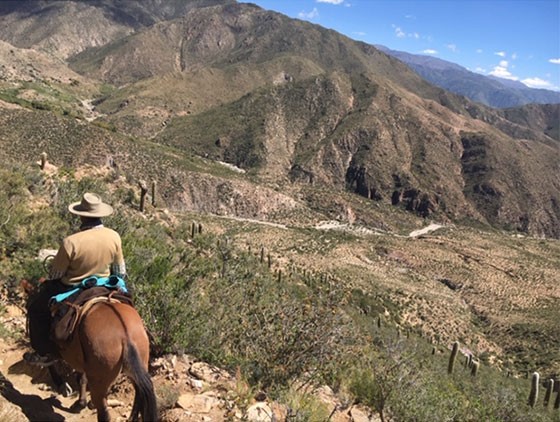
He had intended to leave the hard work to his nephew, Gabriel, thus keeping the place up. But Gabriel made a break for it and now works in the valley.
That leaves Martin in a tough spot. Life up there is very hard…with constant work on the sheep, the goats, the cattle, and the crops.
It is an ideal life, in some ways. The family eats what it raises. It drinks water from the river. It breathes the cool, clean air of a high mountain valley, and may not see a visitor for months at a time. It needs little from the outside world.
But it is gruelling work. And Martin is getting old.
Typically, the women work with the goats and the sheep, leaving the cattle to the men. And typically, it is the men who do the hardest work — fixing the roof with fresh mud, cutting and stacking the alfalfa, preparing the ground for planting a garden, and of course…roping, castrating, branding, and driving the cattle.
Treacherous path
Martin looked at us and gave us a warm welcome. He checked our girth cinches (they are unlike those in North America…tightening them correctly is an art), and we were off… still headed directly towards the mountain that seemed impossible to get over.
Switching back and forth, stumbling on the rocks and stopping from time to time to give the horses a chance to catch their breath, we were soon near the summit. It took about an hour. And at one point, we had to dismount to lead the horses over a particularly treacherous part, where their metal shoes slipped on the well-worn stone.
Martin rode a mule. To us, there always seemed to be something undignified about riding a mule, but it is a surer, more reliable form of locomotion in the mountains. The mule never lost his footing and never seemed out of breath.
Finally, we crested the pass. Below us was a large valley, with a dry river at the bottom and a green patch way off to the left, up near the river’s source. That was Martin’s arriendo (rented property).
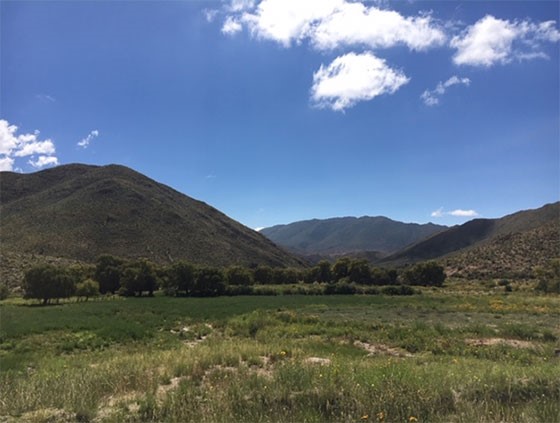
We continued along, downhill now, easier on the horses’ wind… but harder on their legs and balance. Our mount slipped often and fell to the ground once, in a trough cut by travellers over the centuries. We simply put our feet onto the edges of the trench until he recovered his footing.
Old Bayo is getting old, too, like the rider on his back. He suffered most from the hard going, so we exchanged horses with Elizabeth, who is lighter and would be an easier burden.
In an hour or so more, we finally arrived down at the homestead. Green grass, stone walls, willow trees, some abandoned buildings — it was beautiful, remote, and romantic.
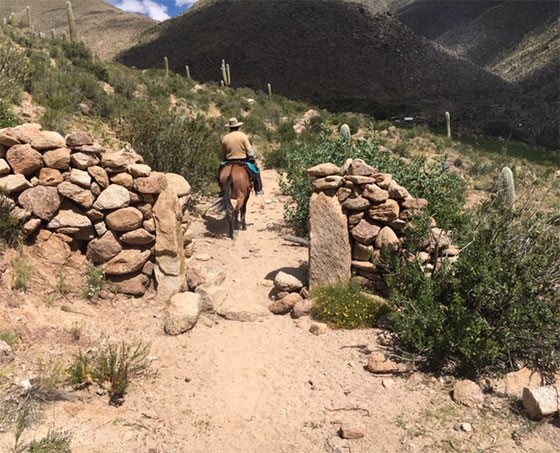
Times have changed
The women kissed us as we dismounted. We exchanged gifts (cheese and apples) and, like old friends, caught each other up on our families.
Martin is very respectful of tradition and rank. And it was not many years ago when class and racial distinctions were carefully observed in the valley.
Until recently, the relationship between owner and arrendero — or ‘peone’ — was one of mutual benefit and customary courtesies. When the peasant had a problem, he came to the owner, counting on him to solve it for him.
The mountain people were unfamiliar with the outside world — the law…finance…modern medicine…and other issues. They turned to the priest…and to the landowner…depending on the nature of the trouble. They might need rafters for an addition to the house…or a loan so they could buy more animals…or intercession with the authorities.
Recently, the police suspected one of our puesteros had either killed his child…or allowed him to die from neglect. Typically, the puestero would come to the landowner and expect him to protect him, making sure he got a fair shake from the law.
But times have changed.
In this case, the puestero had already declared himself an outlaw. He said he was an ‘originario’ with no duties to the owner of the land on which he lived, nor to the police of the province, nor to the health authorities. He wanted nothing to do with any of them, he said.
Both the police and the health authorities turned to us. The police wanted to borrow horses (there is no road to his puesto), in order to ride up and arrest him…which they did.
The public health officials didn’t know what to do. They asked if we would talk some sense into the man. They suspect that the man’s wife is incompetent mentally and should not be having children at all. They hoped we could do something. We explained that he was an originario and wouldn’t even talk to us.
That problem has not been resolved.
Late on rent
Meanwhile, we sat in the courtyard, under a canopy of grapevines, and luncheoned by ourselves. (Martin and his family, while sincerely warm and friendly, did not want to eat with us.)
The house consists of a number of adobe and stone buildings set up around a tiny courtyard. All had dirt floors, but Martin had gotten some bags of cement (on burros) over the mountains and covered the main roofs with a coat of cement and lime, over the mud.
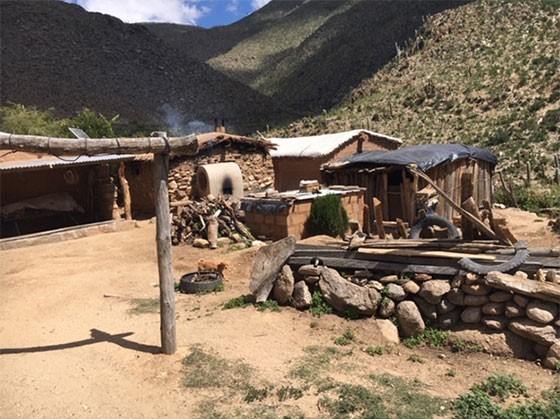
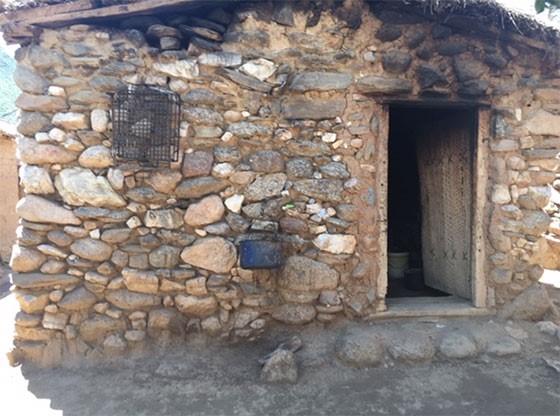
Everywhere, there were bits and pieces of tools, bottles, this-and-that… relics of many projects and much time. It was so difficult to get anything there, they were not about to throw it away, no matter how useless or used-up it appeared.
Lunch over, we chatted about the weather, the lack of water, the treatment of the mountain cattle, worms in the peaches (they don’t have any; we do). And then, it was about 3:00pm. We had about another five hours of daylight. We had to get underway.
‘I’ll come with you,’ said Martin, ‘to show you the way.’
‘You don’t need to do that. The trail is well marked, isn’t it?’
‘Yes, you won’t get lost. But it is dangerous in several places.’
‘Well, I’m not worried about that. We’ve been here for 12 years. We’re used to dangerous trails.’
And so we kissed each of the women — the wife, the sister-in-law, and the daughter — and gave Martin a warm handshake. It was then that he brought up business.
‘I haven’t been able to pay my rent. I guess you know that?’
‘No…nobody told me. But don’t worry about it. Just work out something with the capataz [foreman].’
The rents are symbolic. For a year on an arriendo of 1,000 acres, Martin could owe us about $25 worth of goats. It was not a big deal. But it is important to respect the traditional relationship between owner and renter. Otherwise, people begin to get ideas.
As a practical matter, the land has no value. But we have to protect the frontiers of the ranch and the integrity of its borders. So, we don’t want Martin to turn into an originario and claim it is his.
Then, we would have to take him to court and waste time and money in a confrontation that wouldn’t benefit either one of us.
No hoofprints
We followed the trail out beyond the arriendo and were soon in the dry hills again. Only, they didn’t look familiar.
‘We came from the other direction,’ we assured Elizabeth, ‘that’s why we don’t recognise anything.’
We had left the puesto about a half an hour ago. But following the trail proved harder than we thought. There was more than one trail. One trail led one way. Another, the opposite way. It seemed logical that we take the one that went up a dry creek, to a plausible mountain pass. But it didn’t look right.
‘I don’t remember this at all,’ said Elizabeth.
After a half hour of following the trail, we realised that there were no horseshoe prints on it. We had just come over that path a few hours ago.
There were plenty of hoofprints on the path. But greenhorns that we are, we hadn’t bothered to check them carefully. When we finally did, we saw we were on a cattle path, not the path we wanted. And had we stayed on it, we would have ended up in the high pasture west of the farmhouse, far from where we wanted to be.
We went back down the riverbed. We searched for the right path. What had happened to it? It seemed to disappear. Finally, we gave up.
‘We’ll just have to go back to Martin’s. He’ll think we’re idiots. But we’re losing time and it will be dark soon.’
Worse than that, clouds had gathered overhead. We heard a rumbling sound over the mountain. As unlikely as it was, it looked like it was going to rain. And there was no cover anywhere.
The ride back to Martin’s would take us an hour, to and fro. Best case, we wouldn’t get back home until well after dark. And we didn’t know the trail that well. We might have to stay with Martin for the night. But that would cause problems; when we didn’t show up…the ranch hands would send out a search party to look for us.
These thoughts in mind, we mounted the hillside leading to Martin’s house and looked back. And there it was, as plain as day…a line cut into the greenish dirt of the mountain on the other side. How could we have missed it?
Marta’s dog
We quickly reversed course, turning around, back into the dry riverbed…but this time, going down rather than up, so we were able to pick up the trail a few hundred yards downriver. It was then that we noticed a small dog — a puppy — had decided to join us.
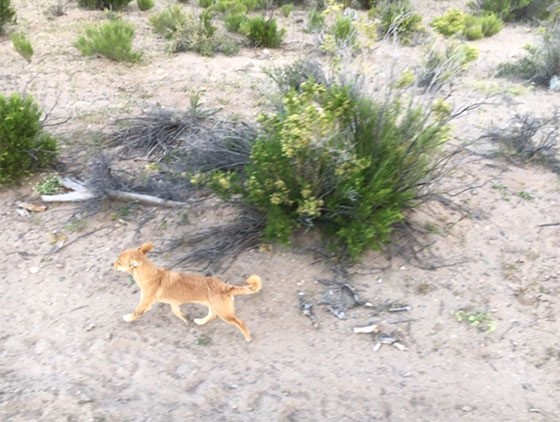
‘Look, it’s Marta’s dog.’ Somehow, Elizabeth knew that the dog belonged to a woman who worked down at the main house.
‘He must know we’re headed back there. He wants to come, too.’
The rest of the ride was uneventful. We led the horses up over the pass, on foot… and down the other side, again, on foot, which was harder on us but easier on them.
And then, from that side of the mountains, it was easy to keep our bearings. Rather than continue on the path whence we came, we decided to follow the river. We knew where it led. And it would be a more pleasant ride — for us and the horses — than over the rocky mountain trails.
And so, we wound our way home… under the willows and molle trees… criss-crossing the shallow river… passing through another puesto we had never seen — where no one was home (and the place was a wreck) — by the old mill…and then, on the familiar road to home.
We rode up at 8:00pm, about 12 hours after we set out.
Regards,
Bill Bonner





Since founding Agora Inc. in 1979, Bill Bonner has found success and garnered camaraderie in numerous communities and industries. A man of many talents, his entrepreneurial savvy, unique writings, philanthropic undertakings, and preservationist activities have all been recognized and awarded by some of America’s most respected authorities. Along with Addison Wiggin, his friend and colleague, Bill has written two New York Times best-selling books, Financial Reckoning Day and Empire of Debt. Both works have been critically acclaimed internationally. With political journalist Lila Rajiva, he wrote his third New York Times best-selling book, Mobs, Messiahs and Markets, which offers concrete advice on how to avoid the public spectacle of modern finance.